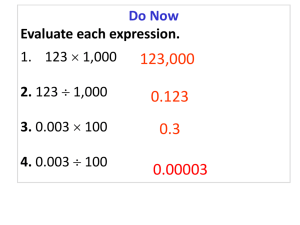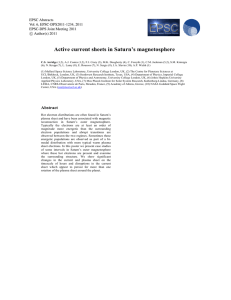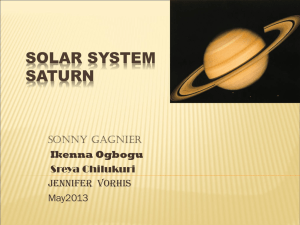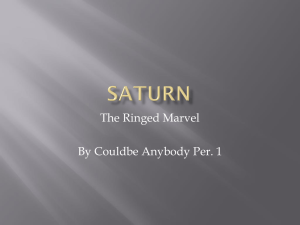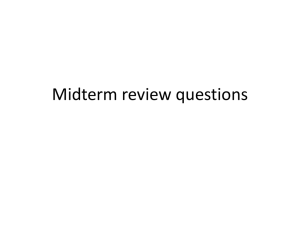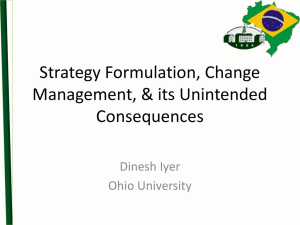ARCHITECTURAL DECISIONS
advertisement
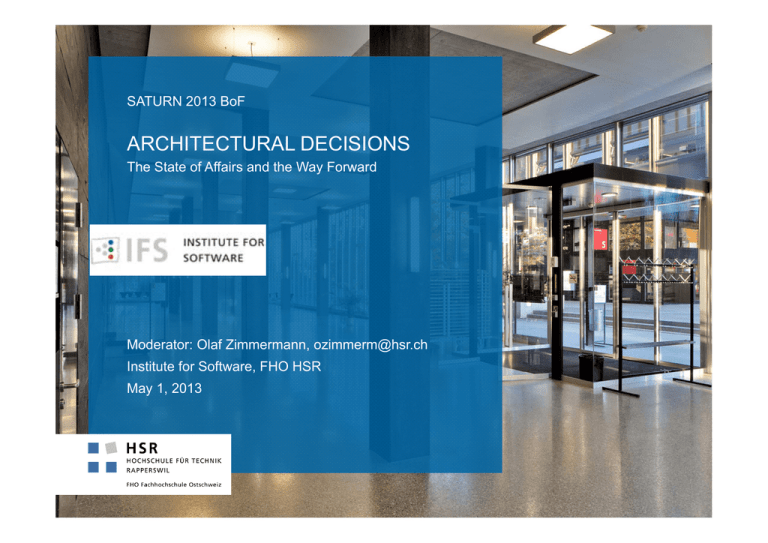
SATURN 2013 BoF ARCHITECTURAL DECISIONS The State of Affairs and the Way Forward Moderator: Olaf Zimmermann, ozimmerm@hsr.ch Institute for Software, FHO HSR May 1, 2013 Context Architectural decisions have been on the radar of practitioners and researchers since the early days of software architecture. The inability to capture and share architectural decisions often results in wasted effort and ineffective use of development resources. In recent years, a number of decision-capturing templates have been proposed and model-driven tools have been released. The 2011 edition of ISO/IEC/IEEE 42010 advises us to provide evidence of consideration of alternatives and the rationale for the choices made. However, this is easier said than done. In practice, busy schedules and project dynamics often cause decision capturing to be sidelined; documentation artifacts become obsolete quickly. There is hope, though. Lightweight decision-capturing approaches have been presented at previous SATURN Conferences, and success with knowledge reuse has been reported. SATURN 2013 - AD BoF Page 2 © Olaf Zimmermann, 2013. Objectives In this birds-of-a-feather session, we would like to gather the collective expertise of the SATURN community regarding architectural decisions: Are you looking for ways to share architectural knowledge within practitioner communities effectively and efficiently? Would you like to hear about the state of the practice in identifying, making, and enforcing decisions – and to help advance it? Do you have decision-capturing practices that work well in your organization that others can benefit from? This session is a highly interactive program element; think of it as a facilitated roundtable meeting. Please bring your questions, experience, opinions, and other discussion input. SATURN 2013 - AD BoF Page 3 © Olaf Zimmermann, 2013. Meet the Experts You, first and foremost! Brief introductions George Fairbanks, Rhino Research/Google, NYC, USA Just Enough Software Architecture, Architectural Haiku (with rationale) Heiko Koziolek, ABB Corporate Research, Germany Area coordinator for sustainable software architectures, AD tooling Cesare Pautasso, USI, Lugano, Switzerland SOA for the REST of us Software Architecture Warehouse, AD collaboration tooling Olaf Zimmermann, FHO HSR, Rapperswil, Switzerland SOA Decision Modeling (2006-2012) Architectural Refactoring for Cloud (method/content/tooling) SATURN 2013 - AD BoF Page 4 © Olaf Zimmermann, 2013. Architectural Decision (AD) 101 Capture the rationale justifying a design Answers to “why” questions Example: “We selected the Layers pattern to make the core banking SOA future proof, e.g., to be able to add user channels in a flexible manner” See http://www.ibm.com/developerworks/architecture/library/ar-knowwiki1 for full example and decision capturing template Practical challenges: Retrospective decision capturing takes time and does not yield sufficient benefits Relation to other architectural concepts and viewpoints (quality attributes, patterns) not understood well and not supported in methods and tools SATURN 2013 - AD BoF Page 5 © Olaf Zimmermann, 2013. Some Motivating Questions How relevant are ADs for project success (and later stages)? How do you identify, make, document, enforce ADs? Do you prefer process/template- or knowledge-centric design? What is the role of semantic technologies and the Web when capturing AD knowledge? Do we need – and can we build – an Archipedia? Tool requirements? Most relevant domains? SOA, Cloud, Web Development – anything else (mobile/big data)? Inhibitors? Cost of collecting and searching vs. rapid information need; QA/curation? Incentives and budget for AD knowledge capturing and sharing? SATURN 2013 - AD BoF Page 6 © Olaf Zimmermann, 2013. Questions from BoF Session Attendees What is the right granularity of/for an AD (scope, reach)? (10 votes) How many ADs to make and capture? (4) What is a good AD log update frequency (anything written is dated)? (7) What makes a good decision? Time needed (wait until end)? (12+) How do ADs relate to project planning (cost, timing of AD making)? (6) How to support half committing (short term vs. long time AD)? (8) Who makes the early Ads (role)? (6) What are the minimal requirements needed to start AD making? (14) How to manage cultural change to share AK? (8) SATURN 2013 - AD BoF Page 7 © Olaf Zimmermann, 2013. More Questions and Discussion Topics from BoF Attendees How to deal with change (in/of solution context), impact on ADs)? (5) What is the difference between ADs and design decisions? (13) How to represent the customer experience in an AD context? (4) How to navigate the universe of alternatives (patterns etc.)? (14) Accountability (7) Reuse of ADs and AD knowledge (10) Technical debt and ADs (cost of making AD late vs. reversing early ADs) (11) SATURN 2013 - AD BoF Page 8 © Olaf Zimmermann, 2013. Discussion Minutes What is the right granularity of/for an AD (scope, reach)? Depends on target audience (e.g. sponsors, developers, other architects) and level of authority (e.g. program vs. project) Depends on experience in development team (talent over architecture) Depends on architecturally significant requirement being addressed (NFR/QA impact of AD) AD must be followed up/executed (success criterion for architecture work!) Time boxing needed, early ADs include choice of architectural style and platform, key patterns Relevance for next steps of project to be considered AD log must still be readable under real world-constraints (same holds for amount of AK captured in a reusable guidance model) Just Enough Software Architecture gives general advice on how much architecture design is enough in a given context (risk-driven approach) See blogs about criteria for architectural significance (sources of AK slide) SATURN 2013 - AD BoF Page 9 © Olaf Zimmermann, 2013. Discussion Minutes What makes a good decision? Time needed (wait until end)? Think about evaluation criterion for AD and alternative/option selected Be accountable, evaluation criterion can be quantitative measure or qualitative indicator (depending on type of decision to be made) Be rigorous (what do civil architects/engineers do when building a bridge?) Conflicts/tradeoffs considered? Soft NFRs addressed (e.g. vendor lockin)? Impact/timing of AD Triangulation, talk to peers w/ different experience (consensus, challenge) Have a plan B/fallback (in case AD cannot be followed and must be revised) SEI hard choices game teaches decision making under constraints See coverage of rationale in IEEE 42010 See SATURN 2013 presentation/tutorial on risk- and cost-driven design See SATURN 2012 presentation and developerWorks article on AD modeling with reuse (justification should include requirements traceability) SATURN 2013 - AD BoF Page 10 © Olaf Zimmermann, 2013. Discussion Minutes What are the minimal requirements needed to start AD making? (14) Leave open – defer AD until last responsible moment (lean/agile principle) Level of commitment differs AD types matter (e.g. executive decisions have a broader range than tactical decisions about certain components) Confidence level of AD, timestamp/validity period Make some ADs twice (short vs. long term design), be ready to undo Find made ADs hiding in requirements and system context (inherited, e.g. from RFP, from previous project, from software package vendor) Understand project/system context Make assumptions explicit, classify them, close gaps (e.g. security requirements, volume metrics) Leverage reference architectures (if they have requirements) Ok to start if minimal product functionality can be delivered If you leave a vacuum (no AD), others will make AD implicitly for you Use your experience and that of your peers, have a vision SATURN 2013 - AD BoF Page 11 © Olaf Zimmermann, 2013. Discussion Minutes How to navigate the universe of alternatives (patterns etc.)? (14) Patterns books are a good start, but knowledge needs to be organized further Pattern usage depends on architectural context AD to pattern relation is not 1:1 Pattern languages help, but only available for some domains Architect is not done when pattern selection has been made – patterns are soft around the edges (AD refinement levels, see SATURN 2010 presentation) Decision trees can be defined Order matters, decision dependencies are both causal and temporal Decision making patterns and anti patterns exist (see JSS article) Architect brain still needed ask people that built systems (known uses) Twin peaks metaphor/picture for dual evolution of requirements and design (same for design elements and design decisions) SATURN 2013 - AD BoF Page 12 © Olaf Zimmermann, 2013. AD Coverage at SATURN 2010-2013 One presentation and tutorial at SATURN 2010 An Architectural Decision Modeling Framework for SOA and Cloud Design Five presentations and one tutorial in 2011 (AD one of seven themes) Architectural Implications of Cloud Computing Guidance Models and Decision-Making Tooling for SOA, Cloud, and Outsourcing Solution Design Dealing with the Complexities of a Global Service-Oriented Architecture Evaluating a Partial Architecture in a ULS Context Themes for Architecture Success Continued coverage in 2012 Y-Template introduced in Making Architectural Knowledge Sustainable AD concept embedded in many presentations in 2013 The Design Space of Modern HTML5/JavaScript Web Applications 8 more presentations mentioning decisions in abstract SATURN 2013 - AD BoF Page 13 © Olaf Zimmermann, 2013. Knowledge Sources (Beyond SATURN) InfoQ, Stack Overflow, TheServerSide.com IBM developerWorks, MSDN and similar vendor-sponsored sites E.g. Google Developers, Amazon developer forums Blogs and websites Peter Eeles, Peter Cripps Gregor Hohpe’s ramblings on eaipatterns.com Martin Fowler’s bliki Philippe Kruchten’s weblog and articles on architecture Michael Stal on blogspot Books and magazines IEEE Software magazine – free multimedia content online Patterns books SEI TRs SATURN 2013 - AD BoF Page 14 © Olaf Zimmermann, 2013. Next Steps Recommended reading list? Community/special interest group? Web site or blog (Word Press)? Mailing list? Twitter? Wikipedia article? SATURN 2013 - AD BoF Page 15 © Olaf Zimmermann, 2013.
